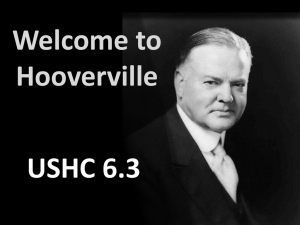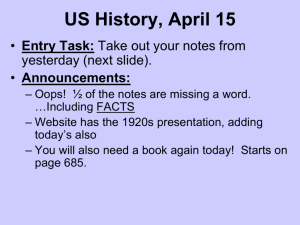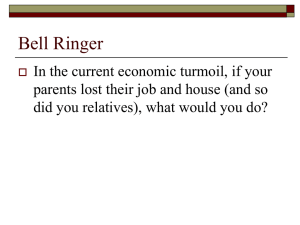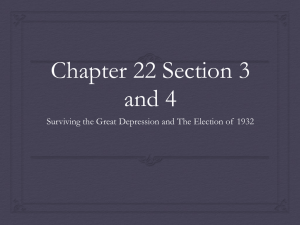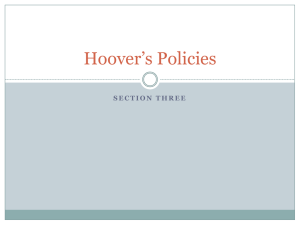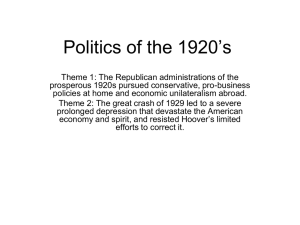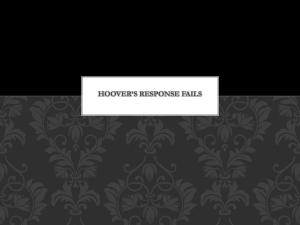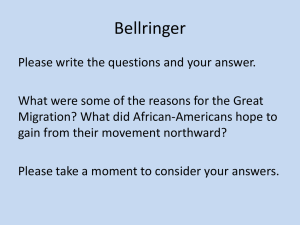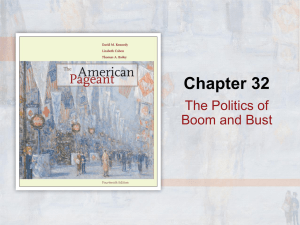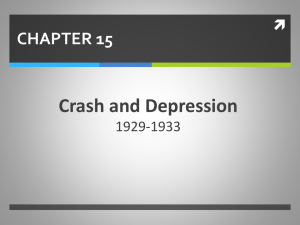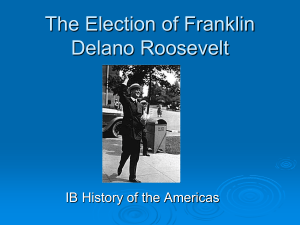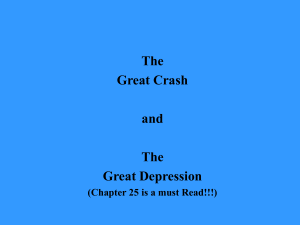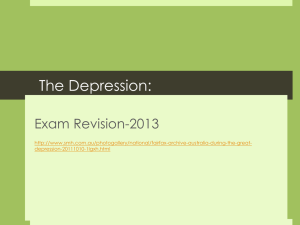In Hoover we trusted and now we are busted.
advertisement
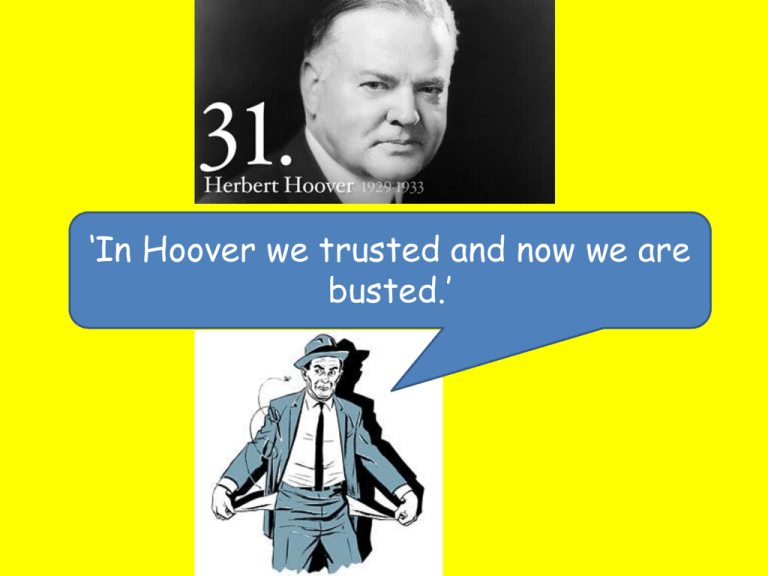
‘In Hoover we trusted and now we are busted.’ THE GREAT DEPRESSION • The depression was a period in the 1930s when the American economy had collapsed. • Between 1929-1932, over 100,000 businesses collapsed and 15 million people became unemployed. • The depression was caused by a number of factors. In your notes draw a spider diagram to show these factors. In the cities…. The car industry was hit hard. In 1930 car production dropped by 30%. Within a year it had dropped by a further 29%. By 1932 production levels were at their lowest since 1918. Many went bankrupt. Desperation was apparent on the streets of Chicago Private charities like the Salvation Army provided soup kitchens for the unemployed. They nicknamed it ‘Hoover stew’. Shanty towns like the one below appeared in cities all over America. They were known as ‘Hoovervilles’. Americans had lost faith in the hard-hearted Republican attitudes towards welfare. In the countryside of the midwest…. The Dust Bowl affected the states of Texas, Colorado, New Mexico, Kansas and Oklahoma. By the 1930s the top soil had became loose due to the planting of wheat during the boom and over-grazing of livestock. High winds and dust storms swept away the top soil of the land and combined with a 7 year drought that began in 1931, destroyed many livelihoods. Families were destitute. The Depression - start at 42mins • https://www.youtube.com/watch?v=bCEJ65H _1XE 1932 – Bonus marchers staged a protest to claim the bonus money promised to them for fighting in the war. They camped around the White House in tents they called ‘Hoovervilles’. Hoover eventually instructed the army to break up the protest using tear gas and tanks! Unemployment 1. What happened to unemployment: • across America • in the major industrial cities? 2. Which group tended to be less affected by unemployment? 3. What relief was available to the unemployed from local / state governments and charities? Life of the unemployed 4. List the key points of evidence given by William Foster on life for the unemployed. 6. Why were people insecure? 7. “People went hungry in one of the richest food producing countries in the world”. Why? 8. What were ‘Hoovervilles’? 9. How did Hoboes live? 10. How did unemployment affect: • suicide rates • marriage levels • crime rates [See source]? 11.How did the government respond to the Bonus Army? Who is to blame for the Depression? "It is not the function of the government to relieve individuals of their responsibilities to their neighbours, or to relieve private institutions of their responsibilities to the public." Hoover. Why did the Republican government continue with rugged individualism? 1. 2. 3. 4. 5. Hoover’s role was to coordinate not to lead Unbalance the budget Create a class of welfare dependents Weaken government Destroy the people’s sense of responsibility – Self help was the way forward Self help failure • Charities, churches and trade unions were unable to provide relief. • Charities could only provide 6% of the aid needed. • States could offer little support as unemployed citizens = lower revenue from taxes. State governments had to cut costs elsewhere. E.g. Arkansas – schools closed for 10months a year in a bid to save money • Hoover believed the old approach of hard work and little interference would create prosperity once again. • Hoover remained hopeful about the situation, claiming in March 1930 that the worst “effects of the crash upon unemployment will have passed during the next 60 days” – this created RESENTMENT and he lost CREDIBILITY. Hoover’s Policies What did he do? How successful? SCHEMES - $423m spent on Government building programme including Hoover Dam Created 21,000 jobs and boosted nearby Las Vegas FARM BONDS – Surplus farm produce was Initial success until 1932 when budget ran purchased at the commercial rate to out. Farmers still overproduced. stabilise prices RAISED TARIFFS - Hawley-Smoot Act 1930 raised tariffs on foreign imports by 50% Foreign countries raised tariffs for US imports RECONSTRUCTION FINANCE CORPORATION was Hoover’s greatest effort to combat the effects of the Depression. Pro’s – Loans to State government - $1.5 billion for public works and $3000 million for relief. $150 million loans to businesses to increase employment. $2 billion in loans to banks, railroad and construction and insurance companies on the brink of collapse (70% of which went to small town banks) Cons – Help was aimed at big business instead of individual poverty. Some argued more should have been spent on relief. ARGUMENT - Was Hoover to blame? • • • • Refused to spend government money Refused to authorise full scale relief programmes Policies were too narrow in scope Unemployment remained high especially in Chicago where it reached 40% • Unpopularity was evident in the 1932 election where he lost with 40% of the votes • He was a scapegoat for the Depression - Will Rogers quipped that a man bit into an apple, found a worm, and exclaimed, “Damn Hoover.” • According to Nixon – “Hoover had the misfortune to hold office at the wrong time”

